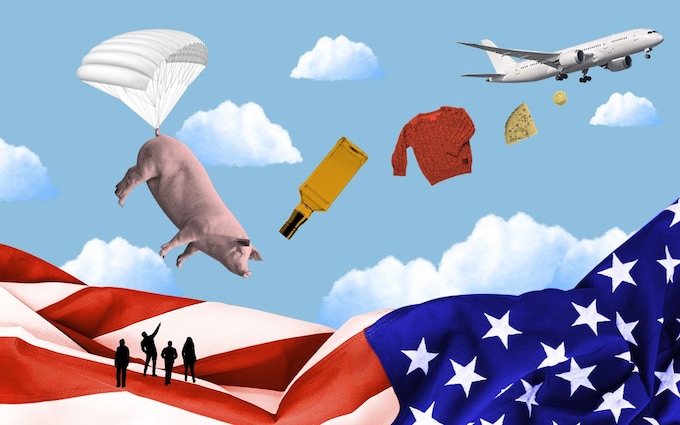Tariff Truce: Maintaining US-China Trade Across The Pacific

Table of Contents
Understanding the History of US-China Trade Tensions and Tariffs
The history of US-China trade relations is marked by periods of cooperation and escalating conflict, often centered around tariffs. The imposition of tariffs by both countries has significantly impacted trade volume and business confidence. This ongoing tension stems from various factors, including trade imbalances, intellectual property rights disputes, and differing economic and political systems.
Key events have shaped this dynamic:
- 2018-2020 Trade War: The Trump administration initiated a series of tariffs on Chinese goods, prompting retaliatory measures from China. This led to significant disruptions in global supply chains and increased uncertainty for businesses.
- Phase One Trade Deal (2020): While offering some temporary relief, this deal did not fully resolve underlying trade tensions.
- Ongoing Tensions: Even with periods of de-escalation, trade tensions persist, particularly concerning technology, intellectual property, and market access.
Specific examples highlight the impact:
- Tariffs on Steel and Aluminum: These tariffs, initially targeting multiple countries, disproportionately affected Chinese exports to the US.
- Tariffs on Consumer Goods: Tariffs on goods like electronics and clothing led to increased prices for American consumers.
- Intellectual Property Rights Disputes: Concerns over the theft of intellectual property and forced technology transfer fueled trade disputes.
Strategies for Businesses to Navigate the Uncertainties of a Tariff Truce
Navigating the complexities of a tariff truce requires proactive strategies from businesses. Uncertainty remains a key challenge, and companies must adapt to maintain competitiveness and profitability.
Diversification of Supply Chains: Reducing reliance on a single source, particularly China, is crucial. This includes exploring alternative sourcing options in other countries like Vietnam, Mexico, or India.
Mitigating Tariff Risks: Strategies like hedging (using financial instruments to protect against price fluctuations) and forward purchasing can help mitigate the impact of potential tariff increases.
Government Support and Trade Agreements: Businesses should leverage government resources, such as trade assistance programs and export financing, to navigate tariff complexities. Staying updated on trade agreements and utilizing their provisions is also crucial.
Examples and tips for businesses:
- Successful Adaptation: Companies like Nike have successfully diversified their manufacturing base to reduce reliance on China.
- Negotiating with Suppliers: Open communication and flexible contract terms are vital when negotiating with Chinese suppliers.
- Government Resources: The US Department of Commerce and other agencies offer valuable resources for businesses affected by tariffs.
The Role of Diplomacy and International Agreements in Maintaining a Tariff Truce
Diplomacy and international cooperation are essential for establishing and maintaining a sustainable tariff truce. De-escalation requires a commitment from both the US and China to address underlying concerns through dialogue and negotiation.
- WTO's Role: The World Trade Organization (WTO) plays a critical role in providing a framework for resolving trade disputes, albeit with limitations in recent years.
- Future Trade Agreements: The potential for new bilateral or multilateral agreements could significantly impact the future of US-China trade relations, potentially reducing reliance on tariffs.
Examples and challenges:
- Successful Diplomatic Initiatives: Past summits and high-level dialogues have demonstrated the potential for de-escalation, though often with temporary effects.
- Challenges to Agreements: Differing political ideologies and economic priorities can create significant hurdles to reaching comprehensive trade agreements.
- Long-Term Implications: A stable US-China trade relationship is crucial for global economic stability and growth.
The Economic Impact of a Stable US-China Trade Relationship
A prolonged trade war between the US and China carries significant global economic consequences. Conversely, a stable trade relationship offers substantial benefits.
- Impact of Tariffs on GDP Growth: Economic data clearly shows the negative impact of tariffs on GDP growth in both countries and globally.
- Industries Benefitting from Stable Trade: Sectors like agriculture, technology, and manufacturing would experience significant positive impacts from reduced trade friction.
- Consumer Prices and Supply Chains: Stable trade leads to lower consumer prices and more efficient global supply chains.
Examples and future potential:
- Economic Data: Studies have shown the negative effects of tariffs on consumer prices and business investment.
- Beneficial Industries: Many industries rely on seamless trade with China for raw materials, components, and market access.
- Future Growth: Reduced trade friction would unlock significant potential for economic growth in both countries and globally.
Securing a Lasting Tariff Truce for US-China Trade
Achieving a lasting tariff truce requires a multifaceted approach. The importance of diversification, risk mitigation strategies, and robust diplomatic efforts cannot be overstated. Businesses must proactively adapt to the ongoing complexities of US-China trade relations. A stable trade relationship benefits both nations and the global economy, fostering growth and prosperity. Understanding the dynamics of a tariff truce is critical for businesses operating in this crucial market. Stay informed and implement the strategies discussed to successfully navigate this complex relationship and safeguard your business's future in the US-China trade arena.

Featured Posts
-
 Dragon Den Winners Lawsuit Puppy Toilet Idea Theft Allegations
May 31, 2025
Dragon Den Winners Lawsuit Puppy Toilet Idea Theft Allegations
May 31, 2025 -
 How To Lose Your Mother A Rapid Review Of Molly Jongs Memoir
May 31, 2025
How To Lose Your Mother A Rapid Review Of Molly Jongs Memoir
May 31, 2025 -
 Duncan Bannatynes Support For Moroccan Childrens Charity
May 31, 2025
Duncan Bannatynes Support For Moroccan Childrens Charity
May 31, 2025 -
 Pw Talks Features Molly Jong Discussion Of Tomorrow Is A New Day
May 31, 2025
Pw Talks Features Molly Jong Discussion Of Tomorrow Is A New Day
May 31, 2025 -
 Cycle News Magazine 2025 Issue 18 Read The Latest Cycling News
May 31, 2025
Cycle News Magazine 2025 Issue 18 Read The Latest Cycling News
May 31, 2025
